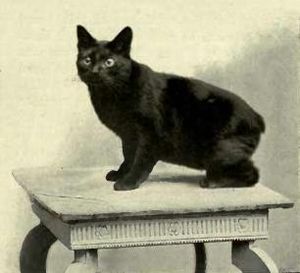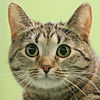Manx (cat)
| Manx | |
|---|---|
| Standard No. | |
| Shoulder height | |
| length | |
| Weight | Male: 5.5 kg. Cat: 3.5 kg |
| allowed colors | |
| colors not allowed | |
| permitted coat drawing | |
| not allowed coat drawing | |
| List of cat breeds | |

|

|
|
|
Isle of Man 1 Crown 1970 with Manx cat
|
||
Manx is a breed of cats that differs from almost all other cats in that it has no tail . This trait originally emerged as a spontaneous gene mutation , but is now selectively promoted by breeders . The Manx cat has been living on in the centuries Irish Sea lying Isle of Man .
root cause
The taillessness of the Manx cat is due to a gene mutation that was presumably preserved in a relatively self-contained region (island) through selection in isolation as a result of extreme inbreeding ( genetic bottleneck ). In addition to the taillessness, there are skeletal and sometimes other malformations . Manx cats with shortened tails are prone to severely painful arthritis and gastrointestinal disorders. The gene responsible for the taillessness can affect the growth of the spine. Then it can come to the development of an open back ( spina bifida ). Manx cats are always mixed breeders in the mutated gene "M" , so they have the combination "Mm". The inheritance is simply autosomal dominant with incomplete penetrance and variable expressivity . In animals with the hereditary gene combination "MM", the fetuses die in the womb - the taillessness is therefore a recessive lethal factor . In order to ensure that no pure-bred animals are produced in breeding, a mating Manx × Manx is normally not allowed in the breeding clubs. You still need a so-called "Outcross" breed, usually British Shorthair , for breeding .
features
The taillessness and body structure not only lead to the hopping gait typical of the Manx cat, as we know it from rabbits , but also to health problems. In addition, due to the lack of a tail, Manx cats have a poorer sense of balance than their fellow cats, which is why they are also poorer climbers.
Manx cats are divided into rumpies , stumpies and tailies . Rumpies are completely tailless, in contrast to stumpies, who at least have a small stump on their rear end. An almost natural tail appears in tailies. In appearance, this cat is round and compact: it has a round head with a round snout, as well as large, round eyes and a short back that curves towards the rounded rump.
Breeding standards
According to the breed standard , the rear of a Manx cat should be higher than the shoulders. The animals should be completely tailless, and there should be no cartilage, bones or the like where the tail would actually be. The fur should be laid twice and feel like a soft cushion, with the undercoat being shorter than the topcoat. A related breed is the Cymric . This has a medium-length coat, the hair of which grows longer from the shoulder to the back. The Manx was already recognized as a breed by the British GCCF in the 1960s, but some associations have refused to do so to this day.
According to an expert opinion prepared in 1999 on behalf of the responsible federal ministry , the Manx cat is a torture breed according to Section 11b of the German Animal Welfare Act . The breeding and exhibition of this breed is therefore de facto forbidden in Germany for animal welfare reasons.
Article 10 of the Swiss Animal Protection Act , which was revised in 2005, can also prohibit the breeding of animals with certain characteristics. In particular, breeds are forbidden, "in which it must be expected that hereditary parts of the body or organs for typical use are missing or redesigned and that this causes pain, suffering or damage to the animal".
In Austria, Section 5 (2) of the Federal Animal Protection Act forbids breeds “which are associated with severe pain, suffering, damage or severe fear for the animal or its offspring.” Whether the Manx cat falls under this is controversial.
Various animal welfare associations also sharply criticize the breeding of Manx cats. However, it continues to be bred as a breed, particularly in the UK and Scandinavia.
health
According to a report by the expert group on animal welfare and pet breeding at the responsible German Federal Ministry, the breed suffers from massive health problems, which results in the classification as torture breeding . Due to genetics, these impairments are extremely common and not only affect individual specimens, two thirds of the animals born alive are born disabled.
Vertebral malformations are common, sometimes with massive defects in the pelvis and spinal cord, neurological deficits, and rectal damage. Spina bifida , urinary and fecal incontinence, the formation of fistulas between the intestine and vagina, and the absence of the anal opening are not uncommon. Other clinical pictures are exophthalmos (protruding eyes) and brain malformations. Completely tailless animals are extremely sensitive to pain in the pelvic area.
The same health problems are to be expected with the similar Cymric .
See also
Web links
Individual evidence
- ↑ John Bradshaw: The world from a cat's point of view. Ways to a Better Coexistence - Findings of a Behavioral Scientist . Kosmos, Stuttgart 2015, ISBN 978-3-440-14326-1 , pedigree cats and extreme forms.
- ↑ SI Bistner, G. Aguirre, JN Shively: Hereditary corneal dystrophy in the Manx cat: a preliminary report. In: Investigative Ophthalmology & Visual Science. Vol. 15, 1976, ISSN 0146-0404 , pp. 15-26, ( online ).
- ↑ Hans-Georg Tacke: On the problem of the "tailless" cats. In: Journal of Anatomy and History of Development . Vol. 106, No. 3, 1936, pp. 343-369, doi : 10.1007 / BF02119656 .
- ↑ http://www.katzenausstellung.de/manxkatze.html
- ↑ Archived copy ( Memento of the original from February 28, 2007 in the Internet Archive ) Info: The archive link was inserted automatically and has not yet been checked. Please check the original and archive link according to the instructions and then remove this notice.
- ↑ http://www.natuerlich-online.ch/nc/magazin/einzelansicht/artikel/01/12/2007/leiden-fuer-den-profit/ ( page no longer available , search in web archives ) Info: The link was automatically marked as defective. Please check the link according to the instructions and then remove this notice.
- ↑ [1]



